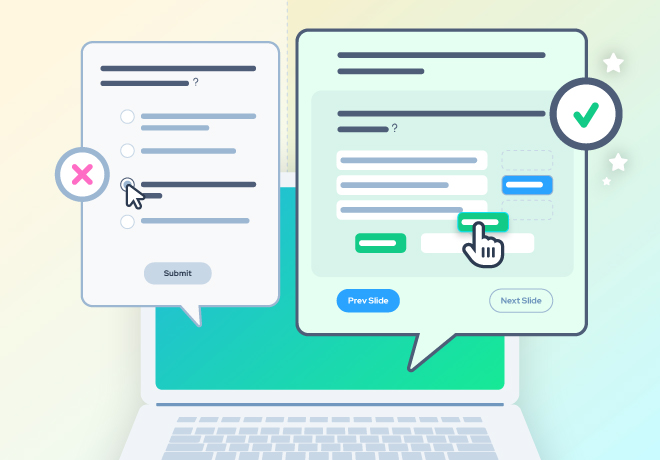
How to engage your adult learners with multimodal eLearning

Related articles
Get valuable eLearning insights to your inbox.
Listen to Neovation’s Demystifying eLearning podcast generated with NotebookLM!
Listen to our podcast on your favorite platform!
Getting learners’ attention is harder than ever. Adult learners are often juggling multiple jobs, families, maybe school … Add to that the constant presence of their smartphones, constantly pinging out notifications.
To gauge what kinds of learning content adult learners look for and are excited about engaging with — what will attract and hold their attention — Training Industry, along with SAP Litmos, conducted a survey of over 1,000 adult learners. Their report, “What Learners Want: Strategies for Training Delivery,” offers several actionable insights for creating quality eLearning content that adult learners will find both engaging and effective.
Do you need to create an engaging training program for adult learners? Get a free quote today to see how Neovation can help you.
Provide on-demand, relevant information

Adult learners have clear beliefs about how they learn best — and they expect to be active participants in their own learning experiences. They do not want to waste time on long courses filled with information they don’t need.
They have also “come to expect on-demand access to job-relevant information,” the report said, likely because that’s how they find information as consumers.
Learning has increasingly become social and informal, too, the survey found.
Ditch generational stereotypes
Adult learners have strong preferences for how they access training content. Variations by industry, type of training, and job role were more striking than by age group, challenging common stereotypes.
Forget “millennials only like video” and other ageist tropes. The survey results show that “what learners want doesn’t differ across generations.” When asked about preferred delivery format or modality, age had little or no influence on preferences and “the order in which each generational group ranked delivery methods was nearly identical.”
Learning preferences are linked to job traits
Rather than breaking along age lines, learners’ preferences had more to do with characteristics of their jobs, their industry, and the type and topic of the training. Key takeaways:
- Those in complex jobs favored eLearning, informal learning opportunities, or virtual training — modalities that allowed for flexible scheduling.
- Managers with multiple direct reports strongly favored self-directed and self-paced learning, preferably mobile.
- Learners found “methods that enable applied practice” to be the most effective; these include on-the-job training or coaching, job aids, and learning simulations.
- A majority of learners preferred instructor-led training, regardless of topic or industry.
Drilling down from learners’ broad preferences, differences emerged based on the type or purpose of training. For compliance training and leadership development training, learners gave eLearning high marks. But they preferred on-the-job training and video-based training in customer service, sales, and for onboarding and learning technical skills.
Bring learning into the workflow
Learners consistently found mobile learning and job aids to be effective — whether or not they had expressed a preference for these modalities. This could be because the on-demand, in-the-workflow nature of these types of content provided learners with the exact information they needed at the moment they needed it.
Multimodal learning is most effective

A common solution that L&D teams deploy is multimodal training. This not only has a better chance of meshing with more learners’ preferences, it’s consistently been found to be highly effective — in fact, the study found that “the sheer number of training methods used to deliver a specific program improved training effectiveness.” Many organizations are taking this to heart: Nearly three-quarters of survey respondents had received multimodal training.
What is multimodal learning?
Multimodal learning in the context of adult learning and corporate training refers to an instructional approach that integrates various sensory and experiential elements to enhance the effectiveness of learning experiences. Instead of relying solely on traditional methods like lectures or written materials, this approach incorporates diverse strategies such as multimedia presentations, interactive workshops, real-world simulations, and collaborative discussions.
When deploying a multimodal learning approach to your online training program you might combine microlearning with job aids and workshops or orientation sessions, for example.
- For an onboarding use case, the multimodal learning program could include an orientation for all new hires on their first day, introducing company values, processes and policies, and walking them through some common new-employee paperwork and other company-wide learning.
- Then, new hires could receive targeted microlearning based on their job roles and departments — different content for the new sales rep and the IT expert, for example.
- They’d all get access to social and collaborative learning sites, where they could access reference guides as well as user-generated and curated content — and where they could chat with peers and more experienced colleagues about how things work and ask questions.
Even within a specific job role or content area, multimodal training can be highly effective.
A long eLearning course could be reinforced with microlearning afterward, for example. That microlearning could include on-demand access to specific bits of information — useful as just-in-time job aids and performance support. Learners who have taken training could informally network and share information and problem-solving tips using an LMS or social network like Slack or Yammer. The LMS could also host short videos and documents that learners can refer to on demand.
Effective and efficient
Creating multimodal content can make training more effective and more efficient — for the content creator as well as for the learners.
When considering custom content development, it’s easier to implement a multimodal approach from the beginning. Designing and developing content in several forms at the outset is more efficient than creating a comprehensive eLearning course — and only afterward coming up with other forms for the content.
A multimodal mindset could result in a blended learning program — or creation of several related resources and activities that present the same concepts in different formats.
Pay attention to learner preferences
Providing training that gives learners what they want pays off. “The largest driver of effectiveness was whether or not [training] was provided through at least one preferred modality,” the Training Industry report said.
Effective training led workers to greater clarity about performance expectations, higher job satisfaction and the perception that their supervisors supported them.
Regardless of industry, training goal, or use case, provide learners with effective, high-quality learning opportunities and consider including engaging multimodal eLearning as part of your larger training program vision.
Learning Hub: free resources for eLearning
The Neovation Learning Hub contains many free resources and articles that can help you improve eLearning outcomes at your organization. Continue learning about Custom eLearning Development topics, read articles on Instructional Design, or find new eLearning tools to help you with your eLearning initiatives.

An experienced writer, editor, tech writer, and blogger, Pam helps you make sense of learning science and eLearning technology. She provides information you can use to drive improvements in your training effectiveness and ROI.
Become part of our L&D community
We publish a new learning hub article — full of useful, practical topics — weekly.
Not sure where where you want to start? Jump into one of our recently published articles and see where it takes you!








-svg.svg)
-svg.svg)
-svg.svg)
-svg.svg)